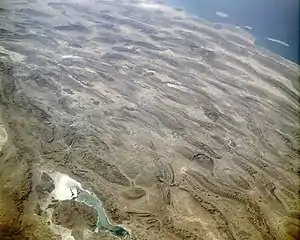Fold mountains
Fold mountains are mountain that are mainly formed by the effects of folding on layers within the upper part of the Earth's crust. Before either plate tectonic theory developed, or the internal architecture of thrust belts became well understood, the term was used for most mountain belts, such as the Himalayas. The term is still fairly common in physical geography literature but has otherwise generally fallen out of use except as described below.

Formation
Fold mountains form when two tectonic plates move towards each other at convergent plate boundary. When plates and the continents riding on them collide, the accumulated layers of rock may crumple and fold like a tablecloth that is pushed across a table, particularly if there is a mechanically weak layer such as salt. The mountains such formed are usually more in length instead of breadth.[1]
Examples
- The Jura mountains – A series of sub-parallel mountainous ridges that formed by folding over a Triassic evaporite decollement due to thrust movements in the foreland of the Alps
- The 'Simply Folded Belt' of the Zagros Mountains – A series of elongated anticlinal domes, mostly formed as detachment folds over underlying thrusts in the foreland of the Zagros collisional belt, generally above a basal decollement that formed in evaporite of the late Neoproterozoic to Early Cambrian Hormuz Formation[1]
- The Akwapim-Togo ranges in Ghana[2]
- The Ridge-and-Valley Appalachians in the eastern part of United States.
See also
- Fault-block mountain – Mountains formed by vertical or tilt displacement of fault blocks
- Mountain formation – The geological processes that underlie the formation of mountains
- Aravalli Range – Mountain range in western India
References
- Ulmer, S. (11 August 2011). "Fold mountains slip on soft areas". ETH Life. ETH Zürich. Retrieved 21 February 2012.
- Kankam-Yeboah, K.; Dapaah-Siakwan, S.; Nishigaki, M.; Komatsu, M. (2003). "The Hydrogeological Setting of Ghana and the Potential for Underground Dams" (PDF). Journal of the Faculty of Environmental Science and Technology. Okayama University. 8 (1): 39–52.